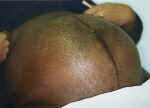|
|
Operational Obstetrics & Gynecology
Normal Pregnancy
Over time, there is a darkening of the maternal skin, in predictable ways.
- Chloasma is a darkening of the facial skin, after the 16th week of pregnancy, particularly in women with darker complexions and significant exposure to the sun.. After delivery, the skin clears, but for some individuals, a persistent darkening of the skin remains.
- Spider telangiectasias are small, bright red, star-shaped skin discolorations that blanch with direct compression and then return as soon as the compression is released. After delivery, they will largely resolve, but some may remain.
- Stretch marks occur primarily in late pregnancy and are due to a separation of the underlying collagen tissue. They are dark red. After delivery, they will gradually lighten, ultimately healing as fine, faint, silvery-gray lines. Who gets them and how severe they are is dependent on the genetic predisposition of the mother and the degree of mechanical stress placed on the skin. There are no scientifically-established methods to either prevent them or treat them. However, generations of women have applied cocoa butter to the skin in the belief that it is helpful.
-
 A "linea nigra" is a dark line running from the pubic bone up the center of
the abdomen to the ribs. This appears late in pregnancy and is due to a combination of
increasing concentration of melanocytes (skin cells capable of darkening) in that area,
plus the high levels of melanocyte stimulating hormone produced by the placenta.
A "linea nigra" is a dark line running from the pubic bone up the center of
the abdomen to the ribs. This appears late in pregnancy and is due to a combination of
increasing concentration of melanocytes (skin cells capable of darkening) in that area,
plus the high levels of melanocyte stimulating hormone produced by the placenta.
Home · Introduction · Medical Support of Women in Field Environments · The Prisoner of War Experience · Routine Care · Pap Smears · Human Papilloma Virus · Contraception · Birth Control Pills · Vulvar Disease · Vaginal Discharge · Abnormal Bleeding · Menstrual Problems · Abdominal Pain · Urination Problems · Menopause · Breast Problems · Sexual Assault · Normal Pregnancy · Abnormal Pregnancy · Normal Labor and Delivery · Problems During Labor and Delivery · Care of the Newborn
|
Bureau of Medicine
and Surgery |
Operational
Obstetrics & Gynecology - 2nd Edition |
This web version of Operational Obstetrics & Gynecology is provided by The Brookside Associates Medical Education Division. It contains original contents from the official US Navy NAVMEDPUB 6300-2C, but has been reformatted for web access and includes advertising and links that were not present in the original version. This web version has not been approved by the Department of the Navy or the Department of Defense. The presence of any advertising on these pages does not constitute an endorsement of that product or service by either the Department of Defense or the Brookside Associates. The Brookside Associates is a private organization, not affiliated with the United States Department of Defense. All material in this version is unclassified.
This formatting © 2006
Medical Education Division,
Brookside Associates, Ltd.
All rights reserved